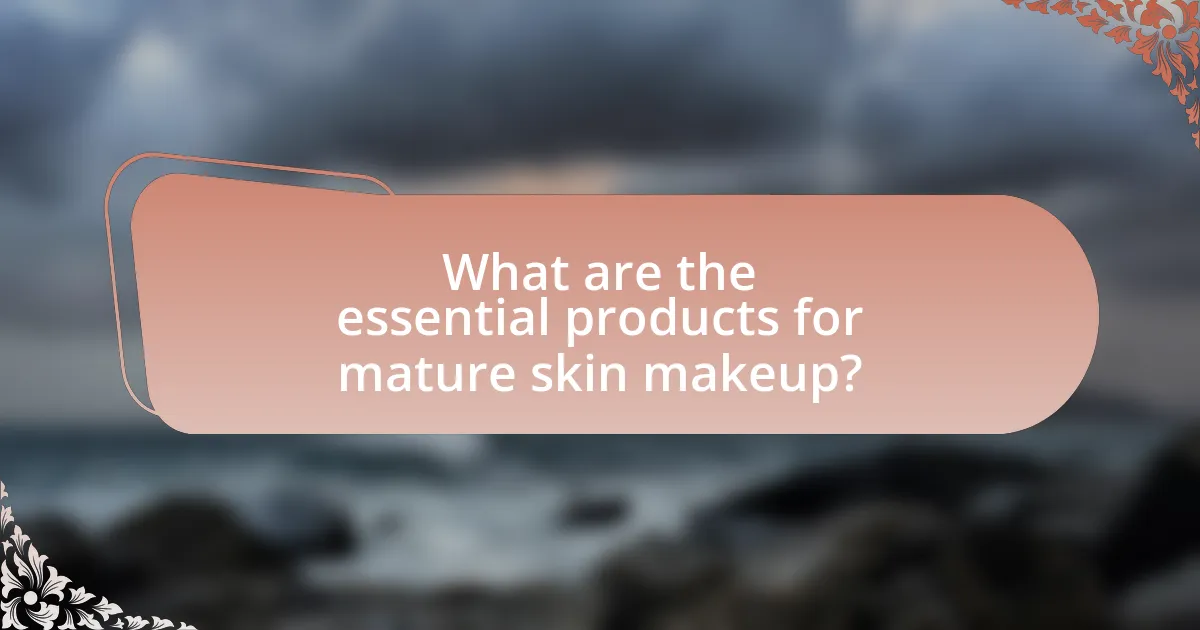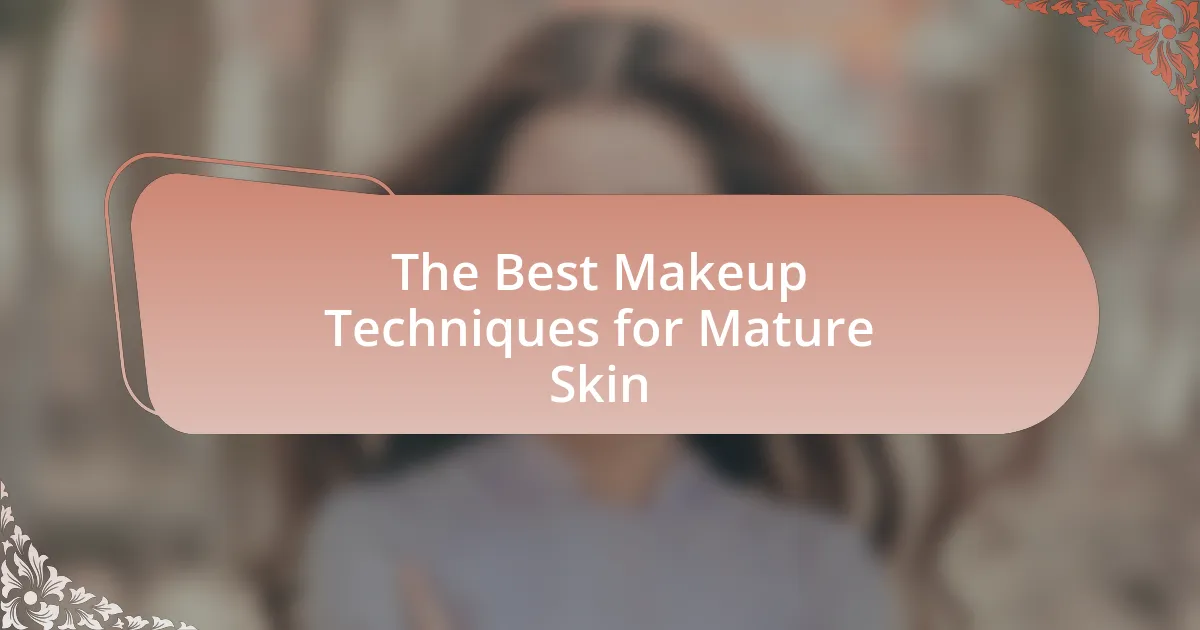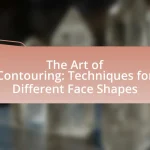The article focuses on the best makeup techniques for mature skin, emphasizing the importance of hydration and natural finishes. Key techniques include using hydrating primers, lightweight foundations, cream-based products, and setting sprays to enhance the skin’s appearance while minimizing the visibility of fine lines and wrinkles. It discusses how aging affects skin texture and elasticity, the challenges faced during makeup application, and the essential products suited for mature skin. Additionally, the article provides practical tips for applying makeup effectively, including the best practices for foundation, concealer, and eye makeup, while highlighting common mistakes to avoid for a more youthful look.

What are the Best Makeup Techniques for Mature Skin?
The best makeup techniques for mature skin include using hydrating primers, lightweight foundations, cream-based products, and setting sprays. Hydrating primers help to create a smooth base and minimize the appearance of fine lines, while lightweight foundations provide coverage without settling into wrinkles. Cream-based products, such as blush and eyeshadow, offer a more natural finish and blend seamlessly into the skin. Setting sprays can help lock in makeup and provide a dewy look, which is often more flattering for mature skin. These techniques are supported by dermatological advice that emphasizes hydration and a natural finish to enhance the skin’s appearance.
How does aging affect the skin’s appearance?
Aging significantly affects the skin’s appearance by reducing collagen production, leading to wrinkles and sagging. As individuals age, the skin loses elasticity and moisture, resulting in a dull complexion and increased visibility of fine lines. Studies indicate that collagen levels decrease by approximately 1% per year after the age of 20, contributing to these visible signs of aging. Additionally, factors such as sun exposure and environmental stressors exacerbate skin aging, further diminishing its youthful appearance.
What changes occur in skin texture and elasticity with age?
With age, skin texture becomes rougher and less smooth, while elasticity decreases significantly. This decline is primarily due to the reduction of collagen and elastin production, which are essential proteins that maintain skin firmness and suppleness. Studies indicate that collagen levels can decrease by approximately 1% per year after the age of 20, leading to visible signs of aging such as sagging and wrinkles. Additionally, the skin’s ability to retain moisture diminishes, resulting in dryness and a lack of radiance. These changes collectively contribute to an overall aged appearance, making it crucial to adapt skincare and makeup techniques for mature skin.
How do fine lines and wrinkles impact makeup application?
Fine lines and wrinkles significantly impact makeup application by affecting how products adhere to and settle on the skin. As skin ages, it loses elasticity and moisture, causing makeup to settle into these lines, which can create an uneven appearance. For instance, traditional foundations may emphasize wrinkles rather than smooth them out, leading to a less flattering look. Additionally, the texture of mature skin often requires lighter, more hydrating formulations to avoid caking and enhance a natural finish. Studies indicate that using products specifically designed for mature skin can improve the overall makeup application experience by providing better coverage and a more youthful appearance.
Why is it important to adapt makeup techniques for mature skin?
Adapting makeup techniques for mature skin is crucial because the skin undergoes changes such as decreased elasticity, increased dryness, and the appearance of fine lines and wrinkles. These changes necessitate the use of specific products and application methods that enhance the skin’s natural beauty while addressing its unique challenges. For instance, using hydrating primers and lightweight foundations can help create a smoother appearance, while avoiding heavy powders can prevent settling into fine lines. Research indicates that 40% of women over 50 report dissatisfaction with makeup products that do not cater to their skin’s evolving needs, highlighting the importance of tailored techniques for achieving a flattering look.
What are the common challenges faced by mature skin during makeup application?
Mature skin faces several common challenges during makeup application, including dryness, fine lines, and uneven texture. These issues arise due to decreased oil production and collagen loss, which can make makeup appear cakey or settle into creases. Additionally, mature skin often has age spots and redness, complicating the even application of foundation and concealer. According to a study published in the Journal of Cosmetic Dermatology, 60% of women over 50 report difficulties with makeup adherence and longevity due to these skin changes.
How can the right techniques enhance natural beauty in mature skin?
The right techniques can enhance natural beauty in mature skin by focusing on hydration, proper application methods, and the use of suitable products. Mature skin often experiences dryness and loss of elasticity, so techniques such as using hydrating primers and lightweight foundations can create a dewy finish that highlights natural radiance. Additionally, applying makeup with gentle tapping motions rather than rubbing can prevent tugging on the skin, preserving its integrity. Research indicates that using products with ingredients like hyaluronic acid and peptides can improve skin texture and appearance, making the makeup look more seamless and enhancing overall beauty.

What are the essential products for mature skin makeup?
The essential products for mature skin makeup include a hydrating primer, lightweight foundation, concealer, cream blush, and a moisturizing setting spray. A hydrating primer helps to create a smooth base and minimizes the appearance of fine lines, while a lightweight foundation provides coverage without settling into wrinkles. Concealer is crucial for brightening under-eye areas and covering age spots. Cream blush adds a natural flush and blends seamlessly into the skin, enhancing a youthful appearance. Finally, a moisturizing setting spray locks in makeup while providing hydration, ensuring a fresh look throughout the day. These products are specifically formulated to address the unique needs of mature skin, promoting a radiant and youthful complexion.
Which foundations are best suited for mature skin?
Foundations best suited for mature skin include hydrating formulas, such as liquid foundations with a dewy finish, cream foundations, and mineral foundations. These types of foundations help to provide moisture, reduce the appearance of fine lines, and create a more youthful glow. For instance, products containing hyaluronic acid or glycerin are effective in maintaining skin hydration, while mineral foundations often contain soothing ingredients that are gentle on aging skin. Additionally, foundations with light to medium coverage are preferable, as they allow the skin to breathe and prevent a cakey appearance.
What should you look for in a foundation for mature skin?
When selecting a foundation for mature skin, prioritize hydrating formulas that contain ingredients like hyaluronic acid, glycerin, or peptides. These components help to maintain moisture and improve skin elasticity, which is crucial as skin tends to become drier and less firm with age. Additionally, opt for foundations with a lightweight, buildable coverage that provides a natural finish, avoiding heavy or matte formulations that can accentuate fine lines and wrinkles. Research indicates that foundations with a dewy finish can enhance the appearance of youthful skin by reflecting light and minimizing the visibility of imperfections.
How do different foundation finishes affect mature skin?
Different foundation finishes significantly affect mature skin by influencing its appearance and texture. Matte finishes can accentuate fine lines and dryness, making skin look older, while dewy or satin finishes provide a more youthful glow and hydration, helping to mask imperfections. Research indicates that mature skin often benefits from hydrating formulas that contain ingredients like hyaluronic acid, which can improve skin elasticity and moisture retention, thus enhancing the overall look when paired with a dewy finish.
What types of concealers work well for mature skin?
Creamy concealers work well for mature skin due to their hydrating properties and ability to provide full coverage without settling into fine lines. These formulations often contain moisturizing ingredients like hyaluronic acid or glycerin, which help to maintain skin elasticity and prevent a cakey appearance. Additionally, liquid concealers with a lightweight texture can also be effective, as they blend seamlessly and offer buildable coverage, making them suitable for covering age spots and dark circles without emphasizing wrinkles.
How can concealers help with age spots and dark circles?
Concealers can effectively mask age spots and dark circles by providing targeted coverage that evens out skin tone. These products contain pigments that blend seamlessly with the skin, allowing them to conceal imperfections such as hyperpigmentation and dark under-eye areas. For instance, concealers with a creamy texture and high pigmentation are particularly effective, as they adhere well to the skin and offer full coverage without settling into fine lines. Additionally, many concealers are formulated with light-reflecting particles that can brighten the under-eye area, further diminishing the appearance of dark circles.
What application techniques enhance concealer effectiveness on mature skin?
To enhance concealer effectiveness on mature skin, use a light, tapping motion with a damp makeup sponge or your fingertip to apply the product. This technique allows for better blending and minimizes the appearance of fine lines and wrinkles. Additionally, applying a hydrating primer or moisturizer before concealer can create a smoother canvas, ensuring the product adheres well and does not settle into creases. Studies indicate that using a lightweight, hydrating formula for concealer can significantly improve the overall finish on mature skin, as it helps maintain moisture and elasticity.

How can you apply makeup effectively on mature skin?
To apply makeup effectively on mature skin, use hydrating products and techniques that enhance rather than mask the skin’s natural texture. Mature skin often has fine lines and dryness, so starting with a moisturizer and a hydrating primer can create a smooth base. For foundation, opt for a lightweight, dewy formula that provides coverage without settling into wrinkles. Applying foundation with a damp sponge can help achieve a more natural finish.
Additionally, use cream-based products for blush and eyeshadow, as they blend more seamlessly into the skin and provide a youthful glow. Setting the makeup with a light, hydrating mist can also help to keep the skin looking fresh throughout the day. Research indicates that using products with ingredients like hyaluronic acid and peptides can improve skin hydration and elasticity, making them ideal for mature skin.
What are the best techniques for applying foundation on mature skin?
The best techniques for applying foundation on mature skin include using a hydrating primer, opting for a lightweight, liquid foundation, and applying with a damp sponge for a seamless finish. Mature skin often has fine lines and dryness, so a hydrating primer helps create a smooth base, while a lightweight foundation prevents settling into wrinkles. Using a damp sponge allows for a more natural application, blending the foundation without emphasizing texture. Additionally, setting the foundation with a light, hydrating setting spray can enhance longevity and maintain a dewy finish.
How does skin prep influence foundation application?
Skin prep significantly influences foundation application by creating a smooth, hydrated base that enhances the foundation’s adherence and finish. Proper skin preparation, which includes cleansing, exfoliating, moisturizing, and priming, ensures that the skin’s texture is even and free from dry patches or excess oil. This results in a more uniform application of foundation, allowing it to blend seamlessly and reducing the likelihood of settling into fine lines or wrinkles. Studies show that using a primer can improve the longevity of foundation wear by up to 8 hours, demonstrating the importance of skin prep in achieving a flawless makeup look.
What tools are recommended for applying foundation on mature skin?
For applying foundation on mature skin, a damp makeup sponge and a foundation brush are recommended tools. A damp makeup sponge helps to blend foundation seamlessly into the skin, providing a natural finish while minimizing the appearance of fine lines and wrinkles. A foundation brush, particularly one with soft bristles, allows for precise application and can help to build coverage without settling into creases. These tools are effective because they promote an even application and enhance the skin’s texture, which is crucial for mature skin that may have more texture and dryness.
How can you enhance the eyes with makeup for mature skin?
To enhance the eyes with makeup for mature skin, use cream-based eyeshadows and soft eyeliners to create a more youthful appearance. Cream eyeshadows provide a smoother application and blend easily, reducing the appearance of fine lines. Soft eyeliners, particularly in shades like brown or plum, can define the eyes without harshness, making them appear larger and more vibrant. Additionally, applying a light, shimmery highlighter to the inner corners of the eyes can brighten the area and create a more awake look. These techniques are effective because they cater to the unique texture and needs of mature skin, which often requires more hydrating and gentle products.
What eyeshadow techniques are flattering for mature eyes?
Flattering eyeshadow techniques for mature eyes include using matte shades, applying eyeshadow in a soft, blended manner, and focusing on the outer corners. Matte shades help reduce the appearance of fine lines and wrinkles, as they do not reflect light like shimmery shades, which can accentuate texture. Soft blending creates a more natural look, avoiding harsh lines that can make eyes appear smaller. Additionally, concentrating color on the outer corners can lift the eyes visually, enhancing their shape. These techniques are supported by makeup artists who emphasize the importance of adapting application methods to suit the changing skin texture associated with aging.
How can eyeliner application differ for mature skin?
Eyeliner application for mature skin often requires adjustments to accommodate changes in skin texture and elasticity. As skin ages, it may become drier and develop fine lines, making traditional eyeliner techniques less effective. For mature skin, using a softer pencil or gel eyeliner can provide a more forgiving application, allowing for smoother lines that do not emphasize wrinkles. Additionally, applying eyeliner closer to the lash line and using a lighter hand can create a more natural look, reducing the appearance of heaviness that can occur with thicker lines. These adjustments are supported by makeup artists who recommend techniques that enhance the eyes without drawing attention to imperfections, ensuring a more youthful appearance.
What tips can help achieve a youthful glow on mature skin?
To achieve a youthful glow on mature skin, prioritize hydration, use illuminating products, and opt for lightweight foundations. Hydration is essential as mature skin often becomes drier; using a rich moisturizer can improve skin texture and radiance. Illuminating products, such as highlighters or illuminating primers, can reflect light and create a youthful sheen. Lightweight foundations help avoid a cakey appearance, allowing the skin’s natural glow to shine through. According to a study published in the Journal of Cosmetic Dermatology, proper hydration and the use of illuminating cosmetics significantly enhance the skin’s luminosity in older adults.
How can highlighters be used effectively on mature skin?
Highlighters can be used effectively on mature skin by opting for cream or liquid formulas that provide a natural, dewy finish rather than powder highlighters, which can settle into fine lines. Applying highlighter to the high points of the face, such as the cheekbones, brow bones, and the bridge of the nose, enhances the skin’s luminosity without emphasizing texture. Additionally, using a light hand during application and blending well ensures a seamless look that avoids a cakey appearance. Studies indicate that cream products are less likely to accentuate wrinkles compared to powders, making them a better choice for mature skin.
What are the best blush techniques for a natural look?
The best blush techniques for a natural look involve applying blush to the apples of the cheeks and blending it upwards towards the temples. This technique mimics the natural flush of the skin and creates a youthful appearance. Using a cream or liquid blush can enhance the natural look, as these formulas blend seamlessly into the skin, providing a dewy finish. Additionally, using a light hand and building up the color gradually ensures a more subtle effect. Studies in cosmetic application have shown that soft, blended edges contribute to a more natural appearance, making these techniques effective for achieving a fresh look on mature skin.
What are the common mistakes to avoid when applying makeup on mature skin?
Common mistakes to avoid when applying makeup on mature skin include using heavy foundations, neglecting skincare, and applying too much product. Heavy foundations can settle into fine lines and wrinkles, making them more noticeable. Skipping skincare can lead to a lack of hydration, which is crucial for mature skin; well-moisturized skin allows makeup to apply more smoothly. Additionally, applying excessive product can create a cakey appearance, emphasizing imperfections rather than enhancing the skin’s natural beauty. These practices are widely recognized in beauty literature, emphasizing the importance of a light touch and proper skincare for achieving a flawless look on mature skin.
How can heavy makeup negatively affect mature skin?
Heavy makeup can negatively affect mature skin by exacerbating dryness, emphasizing fine lines, and causing irritation. As skin matures, it often becomes drier and less elastic, making it more susceptible to the heavy formulations found in thick makeup products. These products can settle into fine lines and wrinkles, making them more noticeable. Additionally, heavy makeup can clog pores and lead to breakouts or irritation, as mature skin may have a more sensitive barrier. Studies indicate that using lighter, hydrating formulations can improve the appearance of mature skin, as they provide moisture without the heaviness that can lead to these adverse effects.
What are the signs of makeup that is not suitable for mature skin?
Makeup that is not suitable for mature skin often appears cakey, emphasizes fine lines, and settles into wrinkles. These signs indicate that the formulation lacks the necessary hydration and flexibility to accommodate the skin’s texture changes with age. Additionally, makeup that is overly matte can make the skin look dull and lifeless, while products with excessive shimmer can highlight imperfections rather than enhance the complexion. The use of heavy foundations can also lead to a mask-like appearance, which is unflattering for mature skin.
What practical tips can enhance makeup application for mature skin?
To enhance makeup application for mature skin, use hydrating primers and lightweight foundations. Hydrating primers create a smooth base, minimizing the appearance of fine lines and dryness, while lightweight foundations provide coverage without settling into creases. Additionally, applying cream products instead of powders can help maintain a youthful glow, as powders may accentuate texture. Using a setting spray can also lock in moisture and provide a dewy finish, which is beneficial for mature skin. These techniques are supported by dermatological advice emphasizing hydration and texture management for aging skin.


